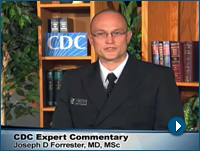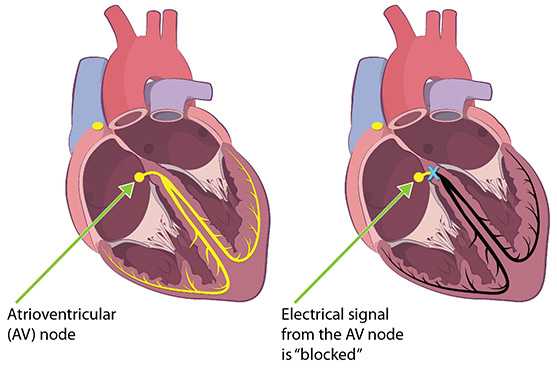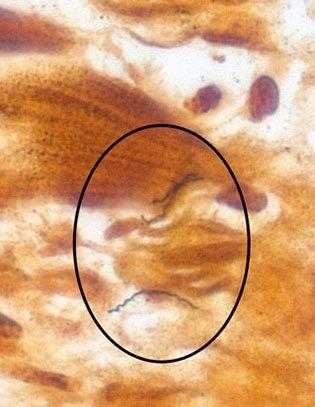What you need to know about Lyme carditis
Videos

Recognizing Lyme Carditis
CDC Expert Commentary, January 2014
What is Lyme carditis, and what are the symptoms?
Lyme carditis occurs when Lyme disease bacteria enter the tissues of the heart. This can interfere with the normal movement of electrical signals from the heart's upper to lower chambers, a process that coordinates the beating of the heart. The result is something physicians call "heart block," which can be mild, moderate, or severe. Heart block from Lyme carditis can progress rapidly.
Patients may experience light-headedness, fainting, shortness of breath, heart palpitations, or chest pain. Patients with Lyme carditis usually have other symptoms such as fever and body aches, and they may have more specific symptoms of Lyme disease, such as the erythema migrans rash.
How common is Lyme carditis?
Based on national surveillance data from 2001-2010, Lyme carditis occurs in approximately 1% of Lyme disease cases reported to CDC.
How is Lyme carditis treated?
Lyme carditis can be treated with oral or intravenous (IV) antibiotics, depending on how severe it is. Some patients might need a temporary pacemaker.
Can Lyme carditis be fatal?
Yes. Between 1985 and 2008, medical journals reported four deaths, worldwide, as a result of Lyme carditis. In December 2013, CDC published a report describing three additional cases [PDF – 28 pages].
How long does it take for a person to recover from Lyme carditis?
Typically the patient receives antibiotic treatment for 14-21 days. Most symptoms are gone within 1-6 weeks.
Third Degree Heart Block

The heart on the left shows how an electrical signal flows from the atrioventricular node (AV node) to the chambers in the lower half of the heart, called the ventricles.
The heart on the right shows a case of third degree heart block. In this illustration, the electrical signal from the AV node to the ventricle is completely blocked. When this happens, the electrical signal of the atria (chambers at the top of the heart) does not transmit to the ventricles (chambers at the bottom of the heart), which causes the ventricles to beat at their own, slower rate.
This report describes three new cases of sudden cardiac death associated with Lyme carditis. The patients, aged 26 to 38 years, lived in areas where Lyme disease is very common.
Pathologists and medical examiners should be aware that Lyme carditis can cause sudden cardiac death. Health-care providers should ask patients with suspected Lyme disease about cardiac symptoms, and conversely, ask patients with acute, unexplained cardiac symptoms about possible tick exposure and symptoms of Lyme disease. Clinicians should encourage all patients to practice tick bite prevention strategies.

Spirochetes in heart tissue. Image taken using Warthin-Starry stain at 158X.
Additional Resources
For more information about heart block, including a video, see: What is Heart Block? by the National Institutes of Health (NIH)
Lyme Carditis [PDF – 14 pages]
Reprinted from Infectious Disease Clinics of North America, Vol. 22/Ed. 2, Fish AE, Pride YB, Pinto DS, Lyme carditis, 275-288, Copyright 2008, with permission from Elsevier.
Forrester JD, Meiman J, Mullins J, Nelson R, Ertel SH, Cartter M, Brown CM, Lijewski V, Schiffman E, Neitzel D, Daly ER, Mathewson AA, Howe W, Lowe LA, Kratz NR, Semple S, Backenson PB, White JL, Kurpiel PM, Rockwell R, Waller K, Johnson DH, Steward C, Batten B, Blau D, DeLeon-Carnes M, Drew C, Muehlenbachs A, Ritter J, Sanders J, Zaki SR, Molins C, Schriefer M, Perea A, Kugeler K, Nelson C, Hinckley A, Mead P; Centers for Disease Control and Prevention (CDC). Notes from the field: update on Lyme carditis, groups at high risk, and frequency of associated sudden cardiac death–United States. MMWR Morb Mortal Wkly Rep. 2014 Oct 31;63(43):982-3.
Muehlenbachs A, Bollweg BC, Schulz TJ, Forrester JD, DeLeon Carnes M, Molins C, Ray GS, Cummings PM, Ritter JM, Blau DM, Andrew TA, Prial M, Ng DL, Prahlow JA, Sanders JH, Shieh WJ, Paddock CD, Schriefer ME, Mead P, Zaki SR. Cardiac tropism of Borrelia burgdorferi: An autopsy study of sudden cardiac death associated with Lyme carditis. Am J Pathol. 2016 May;186(5):1195-205.
- Page last reviewed: March 4, 2015
- Page last updated: July 8, 2016
- Content source:


 ShareCompartir
ShareCompartir